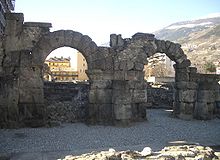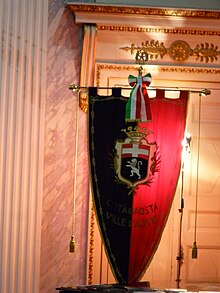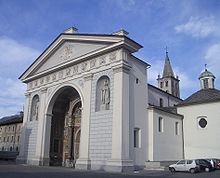Aosta
Aosta
| |
|---|---|
| Città di Aosta Ville d'Aoste | |
 Aerial view of Aosta | |
| Coordinates:45°44′N7°19′E/ 45.733°N 7.317°E | |
| Country | Italy |
| Region | Aosta Valley |
| Frazioni | Arpuilles, Beauregard, Bibian, Bioulaz, Borgnalle, Brenloz, Busséyaz, Cache, La Combe, Les Capucins, Chabloz, Champailler, Collignon, Cossan, Cotreau, Duvet, Entrebin, Excenex, Les Fourches, Laravoire, Montfleury, Movisod, Pallin, Papet, Pléod, Porossan, La Riondaz, La Rochère, Roppoz, Saraillon, Saumont, Seyssinod, Signayes, Talapé, Tsanté, Tzambarlet, Vignole |
| Government | |
| • Mayor | Gianni Nuti(Ind.) |
| Area | |
| • Total | 21.37 km2(8.25 sq mi) |
| Elevation | 583 m (1,913 ft) |
| Population (31 December 2022)[2] | |
| • Total | 33,093 |
| • Density | 1,500/km2(4,000/sq mi) |
| Demonyms | Italian: Aostani French: Aostois Francoprovençal: Veullatsou |
| Time zone | UTC+1(CET) |
| • Summer (DST) | UTC+2(CEST) |
| Postal code | 11100 |
| Dialing code | 0165 |
| Patron saint | St. Gratus |
| Saint day | September 7 |
| Website | Official website |
Aosta(UK:/ɑːˈɒstə/ah-OST-ə,[3]US:/ɑːˈɔːstə/ah-AW-stə,[4]Italian:[aˈɔsta];French:Aoste[a][ɔst])[b]is the principal city of theAosta Valley,a bilingualregionin theItalianAlps,110 km (68 mi) north-northwest ofTurin.It is situated near the Italian entrance of theMont Blanc Tunneland theGreat St Bernard Tunnel,at the confluence of theButhierand theDora Baltea,and at the junction of theGreatandLittle St Bernard Passroutes.
History[edit]


Aosta was settled in proto-historic times and later became a centre of theSalassi,many of whom were killed or sold into slavery by theRomansin 25 BC.[6]The campaign was led byTerentius Varro,who then founded theRomancolony ofAugusta Praetoria Salassorum,housing 3,000 retiredveterans.After 11 BC Aosta became the capital of theAlpes Graiesprovince of theEmpire.Its position at the confluence of two rivers, at the end of theGreatand theLittle St Bernard Pass,gave it considerable military importance, and its layout was that of a Roman military camp.
After the fall of theWestern Empire,the city was conquered, in turn, by theBurgundians,theOstrogoths,and theByzantines.TheLombards,who had annexed it to their Italian kingdom, were expelled by theFrankish EmpireunderPepin the Short.Under his son,Charlemagne,Aosta acquired importance as a post on theVia Francigena,leading fromAachentoItaly.After 888 AD it was part of the renewedKingdom of ItalyunderArduin of IvreaandBerengar of Friuli.
In the 10th century Aosta became part of theKingdom of Burgundy.After the fall of the latter in 1032, it became part of the lands ofCount Humbert IofSavoy.[7]
The privilege of holding the assembly of thestates-generalwas granted to the inhabitants in 1189. An executive council was nominated from this body in 1536, and continued to exist until 1802. After theCongress of Viennarestored the rule of Savoy it was reconstituted and formally recognized byCharles Albert of Sardinia,at the birth of his grandsonPrince Amedeo,who was created duke of Aosta.[7]

Climate[edit]
Aosta is in the rain shadow of theMont Blanc massifand features ahumid subtropical climate(Köppen: Cfa), bordering on acool semi-arid climate(Köppen: BSk), also bordering on anoceanic climate(Köppen: Cfb) and under theKöppen climate classificationdue to its low average annual rainfall. It is considered temperate oceanic (Trewartha: Do) in theTrewartha climate classification.
The city experiences cool to very cold winters, hot summers and relatively dry conditions throughout the year.
| Climate data for Aosta (1991–2020 normals), 547 m asl, extremes since 1984 | |||||||||||||
|---|---|---|---|---|---|---|---|---|---|---|---|---|---|
| Month | Jan | Feb | Mar | Apr | May | Jun | Jul | Aug | Sep | Oct | Nov | Dec | Year |
| Record high °C (°F) | 22.9 (73.2) |
26.0 (78.8) |
26.3 (79.3) |
29.3 (84.7) |
32.2 (90.0) |
40.4 (104.7) |
36.5 (97.7) |
38.0 (100.4) |
34.0 (93.2) |
32.0 (89.6) |
23.0 (73.4) |
21.7 (71.1) |
40.4 (104.7) |
| Mean daily maximum °C (°F) | 6.2 (43.2) |
10.0 (50.0) |
14.6 (58.3) |
18.1 (64.6) |
21.5 (70.7) |
25.1 (77.2) |
28.8 (83.8) |
28.1 (82.6) |
23.1 (73.6) |
17.6 (63.7) |
11.5 (52.7) |
5.1 (41.2) |
18.3 (64.9) |
| Daily mean °C (°F) | 1.5 (34.7) |
4.2 (39.6) |
8.4 (47.1) |
11.6 (52.9) |
15.8 (60.4) |
19.2 (66.6) |
22.2 (72.0) |
21.5 (70.7) |
17.5 (63.5) |
12.2 (54.0) |
6.4 (43.5) |
0.8 (33.4) |
11.7 (53.1) |
| Mean daily minimum °C (°F) | −3.2 (26.2) |
−1.7 (28.9) |
2.2 (36.0) |
5.3 (41.5) |
9.7 (49.5) |
13.3 (55.9) |
15.5 (59.9) |
14.9 (58.8) |
11.7 (53.1) |
6.8 (44.2) |
1.4 (34.5) |
−3.4 (25.9) |
6.0 (42.8) |
| Record low °C (°F) | −17.6 (0.3) |
−15.0 (5.0) |
−15.9 (3.4) |
−8.6 (16.5) |
−3.8 (25.2) |
4.0 (39.2) |
7.0 (44.6) |
6.2 (43.2) |
−3.7 (25.3) |
−12.6 (9.3) |
−14.1 (6.6) |
−18.1 (−0.6) |
−18.1 (−0.6) |
| Averageprecipitationmm (inches) | 33.1 (1.30) |
19.1 (0.75) |
37.3 (1.47) |
28.9 (1.14) |
48.9 (1.93) |
41.2 (1.62) |
27.9 (1.10) |
27.2 (1.07) |
27.0 (1.06) |
42.8 (1.69) |
52.9 (2.08) |
28.0 (1.10) |
414.3 (16.31) |
| Average precipitation days(≥ 1 mm) | 4.1 | 3.9 | 4.7 | 4.5 | 7.4 | 7.3 | 5.5 | 5.1 | 4.1 | 5.3 | 4.9 | 5.0 | 61.8 |
| Source: Météo Climat[8] | |||||||||||||
Main sights[edit]
Prehistoric[edit]
- Saint-Martin-de-Corléans Megalithic Areawith artifacts and tombs dating to theNeolithic era.
Ancient remains[edit]

The ancient town walls ofAugusta Prætoria Salassorumare still preserved almost in their entirety, enclosing a rectangle 724 by 572 metres (2,375 by 1,877 ft).[9]They are 6.4 metres (21 ft) high, built of concrete faced with small blocks of stone. At the bottom, the walls are nearly 2.75 metres (9.0 ft) thick, and at the top 1.83 metres (6.0 ft).
Towersstand at angles to theenceinteand others are positioned at intervals, with two at each of the four gates, making twenty towers in total. They are roughly 6.5 metres (21 ft) square, and project 4.3 metres (14 ft) from the wall. Of the 20 original towers, the following are well preserved:[10]
- Tour du Lépreux(French forLeper's Tower), was given this name after a leper called Pierre-Bernard Guasco was jailed there in the late 17th century.Le lépreux de la cité d'Aoste,a novel byXavier de Maistre,is also named after this leper.
- Tourneuve(13th century).
- Tour du Pailleron.
- Tower (Castle) of Bramafan, built in the 11th century over a Roman bastion. It was the residence of the Savoy viscounts. InFranco-Provençal,Bramé la fanmeans "To scream for hunger".
- Tour du Baillage.
- Tour Fromage.
The east and southgatesexist intact. The latter, a double gate with three arches flanked by two towers known as the Porta Praetoria (1st century AD) was the eastern gate to the city, and has preserved its original forms apart from the marble covering.[11]It is formed by two series of arches enclosing a small square.
The rectangular arrangement of thestreetsis modeled on a Roman plan dividing the town into 64 blocks (insulae). The main road, about 10 metres (33 ft) wide, divides the city into two equal halves, running from east to west. This arrangement makes it clear that guarding the road was the main raison d'être of the city.
TheRoman theatre,of which the southern façade remains today, is 22 metres (72 ft) tall.[12][13]The structure, dating from the late reign ofAugustus,occupied an area of 81 by 64 metres (266 by 210 ft); it could contain up to 4,000 spectators. In the nearby was the amphitheatre, built underClaudius.A marketplace surrounded by storehouses on three sides with atemplein the centre with two on the open (south) side, as well as athermae,have also been discovered.

Outside the town walls is theArch of Augustus,atriumphal archin honour ofAugustus,built in 35 BC to celebrate the victory of consul Varro Murena over the Salassi.[14]About 8 kilometres (5 miles) to the west is a single-archedRoman bridge,called thePont d'Aël.It has a closed passage, lighted by windows for foot passengers in winter, and above it an open footpath.

There are considerable remains of the ancient road fromEporedia(modernIvrea) to Augusta Praetoria into theAosta Valley.The modernrailwayfollows this route, notable for thePont Saint-Martin,which has a single arch with a span of 35 metres (115 ft) and a roadway 4.5 metres (15 ft) wide; the cutting ofDonnas;and the Roman bridges of Cillian (Saint-Vincent) and Aosta (Pont de Pierre).
Other sights[edit]
- TheCathedral,built in the 4th century and replaced in the 11th century by a new edifice dedicated to the Madonna. It is annexed to the Roman Forum.
- TheRomanesque-GothicCollegiate church of Saint Ursus(Saint-Ours). Its most evocative feature is the cloister, which can be entered through a hall on the left of the façade. It is dedicated toUrsus of Aosta.
- The Saint-Bénin College, built about 1000 by theBenedictines.It is now an exhibition site.
- TheBridge of Grand Arvou,a medievalarch bridge-aqueduct.
Transport[edit]
Aosta lies on the crossroad of two major trans-alpinetrunk roads:national road 26 (Italian: SS26, French: RN26[15]) connecting the city ofChivassotoLittle St Bernard Passon theItaly-Franceborder, and national road 27 (Italian: SS27, French: RN27[16]) connecting the city of Aosta to theGreat St Bernard Passon theItaly-Switzerlandborder. Aosta is also served by theA5motorway betweenTurinandCourmayeur.[17]
Aosta railway station,opened in 1886, forms part of theChivasso–Ivrea–Aosta railway.Direct trains only connect Aosta up to the city ofIvrea.The branch line to nearbyPré-Saint-Didier,in theValdigne,on the way towardsCourmayeurwas closed in 2015. Train service is operated byTrenitalia.[18]
The main bus hub is located near the Aosta train station. Buses connect the city of Aosta to the nearby valleys and to destinations outside the region, includingTurin,Milan,Chamonix(France) andMartigny(Switzerland).[19]
Aosta airportis located 5 km to the east of the city.
Notable people[edit]
- List of mayors of Aosta
- Anselm of Aosta(1033–1109),Archbishop of Canterburyfrom 1093 to 1109.[20]
- Xavier de Maistre(1763–1852), writer ofLe lépreux de la cité d'Aoste( "The leper from Aosta", 1811).[21]
- Laurent Cerise(1807–1869), a French physician born in Aosta
- Innocenzo Manzetti(1826–1877), an Italian inventor born in Aosta.
See also[edit]
- Duke of Aosta
- Franco-Provençal language-Valdôtaindialect.
- Aostan French
- Category:Towers in Italy
- Category:Tribes involved in the Gallic Wars
Twin towns - sister cities[edit]
 Chamonix-Mont-Blanc,France
Chamonix-Mont-Blanc,France Kaolack,Senegal
Kaolack,Senegal Martigny,Switzerland
Martigny,Switzerland Narbonne,France
Narbonne,France Sinaia,Romania
Sinaia,Romania
Notes[edit]
- ^FormerlyAouste.
- ^If pronounced inAostan French;[aɔst]if pronounced inStandard French.[5]Arpitan:Aoûta[aˈuta],Veulla[ˈvəla]orOuhta[ˈuhta];Walser:AugschtalorOugstal;Piedmontese:Osta;Latin:Augusta Praetoria Salassorum.
References[edit]
- Inline citations
- ^"Superficie di Comuni Province e Regioni italiane al 9 ottobre 2011".Italian National Institute of Statistics.Retrieved16 March2019.
- ^Bilancio demografico Anno 2013 Novembre (dati provvisori). Provincia: Valle d'Aosta/Vallée d'AosteArchived2016-03-04 at theWayback Machine,Istat.
- ^"Aosta".LexicoUK English Dictionary.Oxford University Press.Archived fromthe originalon 2021-04-23.
- ^"Aosta".Merriam-Webster Dictionary.RetrievedMay 6,2019.
- ^Jean-Marie Pierret (1994).Phonétique historique du français et notions de phonétique générale(in French). Louvain-la-Neuve: Peeters. p. 104.
- ^John Lemprière, Lorenzo DaPonte, & John David Ogilby (1839),Bibliotheca Classica: Or, A Dictionary of All the Principal Names and Terms,(Tenth American Edition), New York: W.E. Dean.Salassi,p. 281
- ^abOne or more of the preceding sentences incorporates text from a publication now in thepublic domain:Chisholm, Hugh,ed. (1911). "Aosta".Encyclopædia Britannica.Vol. 2 (11th ed.). Cambridge University Press. p. 158.
- ^"Météo climat stats Moyennes 1991/2020 Italie (page 1)"(in French).Retrieved14 June2022.
- ^"Aostalife.it - The Town Walls".aostalife.it.Retrieved2017-02-13.
- ^"Aostalife.it - The Towers".aostalife.it.Retrieved2017-02-13.
- ^Toy, Sidney. Castles: Their Construction and History. New York: Dover Publications, 1985. p. 30.
- ^"Aostalife.it - The Roman Theatre".aostalife.it.Retrieved2017-02-13.
- ^"Roman Theatre | Aosta Valley".lovevda.it.Retrieved2017-02-13.
- ^"Aostalife.it - The Arch of Augustus".aostalife.it.Retrieved2017-02-13.
- ^Bulletin officiel de la région autonome Vallée d'Aoste - n.12/2012
- ^Bulletin officiel de la région autonome Vallée d'Aoste - n.12/2012
- ^"Our Network - Autostrade per l'Italia".autostrade.it.Retrieved2017-02-13.
- ^"Acquista il biglietto con le nostre offerte - Trenitalia".trenitalia(in Italian).Retrieved2017-02-09.
- ^Sanson, Fabrizio."Home SAVDA Autoservizi e Autolinee della Valle d'Aosta".savda.it(in Italian).Retrieved2017-02-09.
- ^.Encyclopædia Britannica.Vol. 2 (11th ed.). 1911. pp. 81–83.
- ^.Encyclopædia Britannica.Vol. 17 (11th ed.). 1911. p. 446.
- ^"Relazione al Conto Consuntivo"(PDF).comune.aosta.it(in Italian). Aosta. 2017. p. 107. Archived fromthe original(PDF)on 2021-04-20.Retrieved2019-12-13.
- ^"Coopération Internationale".chamonix.fr(in French). Chamonix-Mont-Blanc.Retrieved2019-12-13.
- General references
- This article incorporates text from a publication now in thepublic domain:Chisholm, Hugh,ed. (1911). "Aosta".Encyclopædia Britannica(11th ed.). Cambridge University Press.
Further reading[edit]
- Lin Colliard,La vieille Aoste,éd. Musumeci, Aoste, 1972.
- Aimé Chenal,Promenade archéologique de la ville d'Aoste,ITLA, Aoste, 1965.
- Mauro Caniggia Nicolotti & Luca Poggianti,Aoste inconnue: traces cachées, oubliées ou invisibles de la vieille ville,typog. La Vallée, Aoste, 2010.
- Carlo Promis,Le antichità di Aosta,(Turin, 1862);
- Édouard Bérard,Atti della Società di Archeologia di Torino,iii. 119 seq.;Notizie degli Scavi,passim.
External links[edit]
- Photos of AostaArchived2021-11-17 at theWayback Machine
- Virtual Museum Vallée (VMV), virtual museum of Aosta city
- Augusta PraetoriaSite plan & photos from the Aosta Valley Regional Authority.
- Ancient Places TV: HD Video of Aosta, Italy






